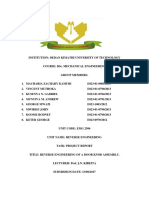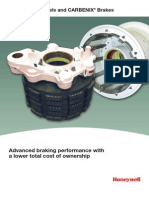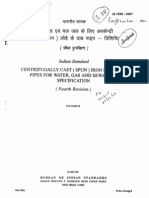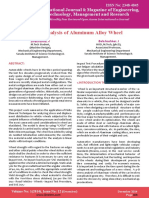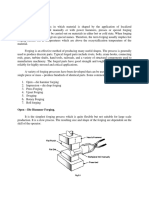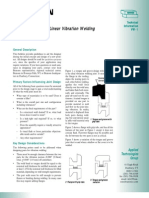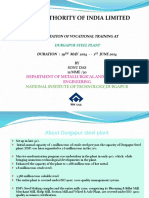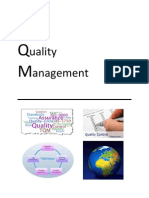CV Joints
CV Joints
Uploaded by
Lorena BakerCopyright:
Available Formats
CV Joints
CV Joints
Uploaded by
Lorena BakerOriginal Title
Copyright
Available Formats
Share this document
Did you find this document useful?
Is this content inappropriate?
Copyright:
Available Formats
CV Joints
CV Joints
Uploaded by
Lorena BakerCopyright:
Available Formats
Drive Line & Transmission
Constant Velocity Joints and Driveshafts
Corus steels for drive line systems consistently withstand heavy loads in delivering power to the steered wheels of modern vehicles. CV joints and driveshafts are made and finished to high standards for reliable and efficient operation. Forming hot forging, cold forging, Corus offers steels specifically machining, tailored to optimise individual component manufacture.
Steel
composition, cleanness, hardenability
Performance
strength, fatigue resistance, wear resistance,
Heat Treatment
induction hardening, case carburising
Performance Requirements
The torsional loading and rotational motion in the system determine the main requirements for CV joints and driveshafts: High strength with a tough core Hard wear resistant surface Resistance to failure by torsional and rolling contact fatigue
Design Criteria
cost, weight, durability, packaging, loading
Material Requirements
Outer races and driveshafts are made from medium carbon through hardening steels. Inner races and tripods are made from low carbon carburising steels. Steels with optimised performance and reduced through costs are required. In addition to the standard grades Corus offers enhanced steels with some, or all, of the following optional characteristics: Controlled sulphur content balances the conflicting requirements of low sulphur for formability and fatigue properties, and high sulphur for improved machinability Controlled hardenability steels with tight compositional control ensure repeatability of mechanical properties Defect free bar prevents cracking during warm or cold forging Controlled carbon content produces consistent response to induction hardening of outer races and driveshafts
Manufacturing Requirements
The outer races are precision formed usually by warm forging from bar, followed by machining and induction hardening. Inner races and tripods are cold forged, machined and carburise heat treated. Drive shafts are produced from peeled bar and the splines are formed by cold rolling. The entire surface is then induction hardened. An efficient manufacturing process for each of these components demands: Sufficient ductility for the forming process Good machinability Consistent and repeatable response to heat treatment
Future Developments
Tripod Outboard Outer Race Driveshaft Inboard Outer Race Outboard Inner Race Lean Manufacturing, throughout the supply chain, offers the most scope for further improved value CV joints and driveshafts. Existing steel enhancements fully satisfy anticipated future performance requirements.
Constant Velocity Joints and Driveshafts
Material Selection
Steels for CV joints and driveshafts are highly developed products. Appropriate grades for the different applications, and their typical chemical composition (wt %) are:
Designation
Mn
Cr
Mo
Component
C50*
0.50 0.45 0.38 0.16 0.20 0.18
0.75 0.75 0.95 1.15 1.25 0.75
0.015 0.025 0.030 0.030 0.030 0.030
1.00 1.15 1.00
0.20
Outer Races
C45
38B3 16MnCr5 20MnCr5 18CrMo4
Driveshafts 0.002
Inner Races and Tripods
* C50 is used for both outer races and driveshafts. Lower sulphur levels for improved formability are normally specified for outer races.
Material Properties
Consistency of Induction Hardening Response
Calculated from the chemical composition, the ideal diameter (DI) is a recognised measure of hardenability. Using fully computerised control of steelmaking and models of hardenability response, Corus enhanced 38B3 driveshaft steel achieves a narrow 10mm range of DI, fully satisfying customers needs for tight specifications to control variations in mechanical properties. This consistency is a significant improvement on comparable standard steels which typically have a DI range >50mm.
Consistency of Hardenability
Corus achieves tight control of hardenability from cast to cast. Results on over 50 casts of 16MnCr5 steel fall within a much narrower hardenability band than specified by the recognised standard BS EN 10084:1998
Distribution of DI
35
Hardenability Control
Steel grade: 38B3
50 45
Steel grade: 16MnCr5
30
20 15 10 5 0 38 39 40 41 42 43 44 45 46 47 48 49 50
Hardness (HRc)
Frequency (%)
25
40 35 30 25 20 15 0 10 20 30 40 50
DI (mm) Corus
Position (mm) BS EN
Corus steels for CV joints and driveshafts are used by: Fiat, Honda, Land Rover, Nissan, Opel, Rover, Toyota, VW Corus Engineering Steels PO Box 50 Aldwarke Lane Rotherham S60 1DW United Kingdom Telephone +44 (0) 1709 371234 Facsimile +44 (0) 1709 826233 www.corusengineeringsteels.com
You might also like
- Roll Bending Springback EffectDocument6 pagesRoll Bending Springback Effectayamdelicious100% (1)
- Vehicles Australian Design RulesDocument3 pagesVehicles Australian Design RulesBogdan PuiaNo ratings yet
- Ticona Molded Plastic Gear Design PDFDocument6 pagesTicona Molded Plastic Gear Design PDFMonica BoccaNo ratings yet
- PS - PSL Operation Manual 2013Document127 pagesPS - PSL Operation Manual 2013MatheusNo ratings yet
- Metcar Physical Properties PDFDocument3 pagesMetcar Physical Properties PDFJavad AmnianNo ratings yet
- TPM Preventive Maintenance ReportDocument27 pagesTPM Preventive Maintenance ReportSreenath Hacko100% (3)
- STS I-IiiDocument25 pagesSTS I-Iiivenzo zufarNo ratings yet
- 4-Machining Fundamentals Ams May01 13Document87 pages4-Machining Fundamentals Ams May01 13mjdaleneziNo ratings yet
- CastingDocument12 pagesCastingFarhan KhanNo ratings yet
- Co2 MoldingDocument9 pagesCo2 MoldingRahul Kumar SinhaNo ratings yet
- Sheet Metal FormingDocument5 pagesSheet Metal FormingScribdd3r100% (2)
- Microsoft PowerPoint - 5-Sheet MetalworkingDocument26 pagesMicrosoft PowerPoint - 5-Sheet MetalworkingRama SatriotamaNo ratings yet
- Engineering Plastic InjectionDocument10 pagesEngineering Plastic InjectionAditya HenryNo ratings yet
- Door KnobDocument18 pagesDoor KnobVasda VinciNo ratings yet
- CH-1 MachiningDocument29 pagesCH-1 MachiningAbreham DerejeNo ratings yet
- A380 Carbenix Data Sheet USDocument2 pagesA380 Carbenix Data Sheet USJonathan WardropNo ratings yet
- Die BasicsDocument2 pagesDie BasicsCosmin TanaseNo ratings yet
- Bollhoff HeliCoil Aerospace Blue BookDocument35 pagesBollhoff HeliCoil Aerospace Blue BookAce Industrial SuppliesNo ratings yet
- Tolerances and FitsDocument20 pagesTolerances and FitsDrmanal Amin100% (1)
- Custom Three Post Progressive Stamping Die Design With Feeder CoilerDocument3 pagesCustom Three Post Progressive Stamping Die Design With Feeder CoilerSIMONENo ratings yet
- GE Transportation: 3.may.2012 General Tolerance Specification Rev. DDocument6 pagesGE Transportation: 3.may.2012 General Tolerance Specification Rev. DMy Dad My WorldNo ratings yet
- Din En12020-2001Document15 pagesDin En12020-2001Ricardo VitorianoNo ratings yet
- M - I U - 1 C P: Anufacturing Processes NIT Asting RocessesDocument246 pagesM - I U - 1 C P: Anufacturing Processes NIT Asting RocessesMahesh SalotagiNo ratings yet
- Saej1885 2008Document21 pagesSaej1885 2008Ying QuNo ratings yet
- AnwanaDocument16 pagesAnwanaHiongyiiNo ratings yet
- Technical Specifications For Door Trim Panel Assembly: PDF Created With Pdffactory Pro Trial VersionDocument15 pagesTechnical Specifications For Door Trim Panel Assembly: PDF Created With Pdffactory Pro Trial VersionDiego Camargo100% (1)
- 2 Basic Principles of Metal FormingDocument28 pages2 Basic Principles of Metal Formingshreeshail_mp6009No ratings yet
- E9d0' R""o .: Indian StandardDocument26 pagesE9d0' R""o .: Indian Standards_samirkumar1008100% (1)
- Plastic Gear Design BasicsDocument6 pagesPlastic Gear Design BasicsMilos VeljkovićNo ratings yet
- Topic 2 Property Enhancing and Surface Processing Operations 2017Document87 pagesTopic 2 Property Enhancing and Surface Processing Operations 2017lim50% (2)
- Sheet Metal Gauge ChartDocument4 pagesSheet Metal Gauge Chartahmed100% (1)
- Screenshot 2023-09-06 at 10.24.31 AMDocument162 pagesScreenshot 2023-09-06 at 10.24.31 AMp9mn4tftqxNo ratings yet
- CV JointDocument7 pagesCV JointAnyia ArcherNo ratings yet
- Cotter Pins - Split PinsDocument2 pagesCotter Pins - Split Pinsguri317No ratings yet
- Heatstake Guide LinesDocument17 pagesHeatstake Guide LinesJereRAESNo ratings yet
- Houston Impact of J-STD-001F and IPC-A-610F ChangesDocument36 pagesHouston Impact of J-STD-001F and IPC-A-610F Changes安靖No ratings yet
- Impact Analysis of Aluminum Alloy Wheel - (V. Sivakrishna, J. Balabashker) PDFDocument11 pagesImpact Analysis of Aluminum Alloy Wheel - (V. Sivakrishna, J. Balabashker) PDFpezz07No ratings yet
- Training ReportDocument34 pagesTraining ReportVarun AggarwalNo ratings yet
- Revised Project Approval Form 2Document8 pagesRevised Project Approval Form 2gauravNo ratings yet
- 8d's y 5 Por Que de NissanDocument8 pages8d's y 5 Por Que de NissanSergio RuizNo ratings yet
- Durability Assessments of Motorcycle Handlebars Ken-Yuan Lin, 2005 XXXXXDocument25 pagesDurability Assessments of Motorcycle Handlebars Ken-Yuan Lin, 2005 XXXXXjaydeepnaruleNo ratings yet
- AnodizingDocument13 pagesAnodizingRatheesh VidyadharanNo ratings yet
- ForgingDocument12 pagesForgingRamanvlr100% (1)
- Iso 14 1982Document10 pagesIso 14 1982LotharSchmidtNo ratings yet
- Microstructure and Mechanical Properties of Resistance Upset Butt Welded 304Document11 pagesMicrostructure and Mechanical Properties of Resistance Upset Butt Welded 304Ashkaan OzlatiNo ratings yet
- Linear Vibration Welding Design GuideDocument2 pagesLinear Vibration Welding Design GuideguptaashishNo ratings yet
- Rynite Pet DupontDocument28 pagesRynite Pet Dupontpirom_popirom500No ratings yet
- Boundary Dimensions and Bearing Number CodesDocument4 pagesBoundary Dimensions and Bearing Number CodesPutra Kanjeng Romo RomoNo ratings yet
- Experience With Large, High-Speed Load Gears: Erwin Dehner and Francois WeberDocument11 pagesExperience With Large, High-Speed Load Gears: Erwin Dehner and Francois WeberHernan GirautNo ratings yet
- Sleeve Bearing Load LimitsDocument2 pagesSleeve Bearing Load Limitssperthawin2787630No ratings yet
- Mahindra 3X0 AccessoriesDocument10 pagesMahindra 3X0 AccessoriesSaikatNo ratings yet
- Design For ManufacturingDocument13 pagesDesign For Manufacturingchalapathy_83100% (1)
- CNC Pipe Bending - Technical NotesDocument21 pagesCNC Pipe Bending - Technical NotesbaanaadiNo ratings yet
- Barras de Acero de Uso en AutomovilesDocument4 pagesBarras de Acero de Uso en AutomovilesMarlon Berroteran TovarNo ratings yet
- Automotive ComponentsDocument12 pagesAutomotive ComponentsfightingfalconNo ratings yet
- ColdRolledSteel PDFDocument32 pagesColdRolledSteel PDFeduardomacieldelimaNo ratings yet
- Tailor Welded BlanksDocument52 pagesTailor Welded BlanksYuvaraj YuvarajNo ratings yet
- AK Hot Rolled Steel 062212 HSLA 60Document6 pagesAK Hot Rolled Steel 062212 HSLA 60Alexandre Lima LopesNo ratings yet
- Design of Machine ElementsDocument83 pagesDesign of Machine ElementsAyush Bhardwaj100% (1)
- Selection, Protection & Detailing ReinforcementDocument19 pagesSelection, Protection & Detailing ReinforcementSa ReddiNo ratings yet
- Lab 01Document17 pagesLab 01sisacs2002No ratings yet
- Material Requirements Planning in A Demand Driven World: Carol PtakDocument32 pagesMaterial Requirements Planning in A Demand Driven World: Carol PtakWill Jin0% (1)
- K012556370 PDFDocument8 pagesK012556370 PDFVan ToanNo ratings yet
- Ipp Tag FormatDocument1 pageIpp Tag FormatSKAI AUTO100% (1)
- Machine(s) : Date: Product: Shift: Availability: Min Min: Page 1 of 1Document3 pagesMachine(s) : Date: Product: Shift: Availability: Min Min: Page 1 of 1chteo1976No ratings yet
- Case Study Pantaloon RetailDocument8 pagesCase Study Pantaloon RetailShruti AgrawalNo ratings yet
- CH 20Document53 pagesCH 20Sergio Hoffman100% (1)
- Complete Heat Treatment Solutions: Projects and ServicesDocument2 pagesComplete Heat Treatment Solutions: Projects and ServicesAbhayaSimhaNo ratings yet
- List of ECSS-DRDs (Issue17-15February2017)Document8 pagesList of ECSS-DRDs (Issue17-15February2017)iconoclasticjarheadNo ratings yet
- P G CompileDocument13 pagesP G CompileShaheer ShahNo ratings yet
- APQPDocument38 pagesAPQPJetesh Devgun100% (1)
- Flow Control ManifoldsDocument4 pagesFlow Control ManifoldsBrayan AguileraNo ratings yet
- Chapter 14Document29 pagesChapter 14Syed Ahmad Ali LCM-3808No ratings yet
- Ford Motor Company: Supply Chain Strategy: Presentation By: GROUP 7Document21 pagesFord Motor Company: Supply Chain Strategy: Presentation By: GROUP 7AnkitNo ratings yet
- Handout Topic 1 Introduction To Operations ManagementDocument56 pagesHandout Topic 1 Introduction To Operations Managementaisyahphilips100% (1)
- Basic Mas ConceptsDocument7 pagesBasic Mas Conceptsjulia4razoNo ratings yet
- Scheduling Job Shop - A CasestudyDocument8 pagesScheduling Job Shop - A Casestudyabbas6063No ratings yet
- Food Safety & HACCP GFSI Benchmarked Schemes: A Look at FS22000 & SQFDocument34 pagesFood Safety & HACCP GFSI Benchmarked Schemes: A Look at FS22000 & SQFDeparted MoonNo ratings yet
- DocumetsDocument11 pagesDocumetsaboemadaldeenNo ratings yet
- Chapter 15Document21 pagesChapter 15randyNo ratings yet
- Plant Layout Assignment 1Document1 pagePlant Layout Assignment 1Naol KefyalewNo ratings yet
- G DHS 1Document22 pagesG DHS 1Sergio Boillos100% (1)
- Steel Authority of India Limited: Presentation of Vocational Training atDocument11 pagesSteel Authority of India Limited: Presentation of Vocational Training atArkadev GhoshNo ratings yet
- SPRDDocument49 pagesSPRDnomurapreNo ratings yet
- Total Quality Management (Report)Document47 pagesTotal Quality Management (Report)Hassaan AhmadNo ratings yet
- TPM Training MaterialDocument87 pagesTPM Training MaterialNsidibe Michael Etim100% (1)
- Chap 004 Process CostingDocument116 pagesChap 004 Process CostingdhominicNo ratings yet
- 7+1 Wastes Worksheet-Jan2013Document2 pages7+1 Wastes Worksheet-Jan2013James YenchoNo ratings yet
- ISO DiscussionDocument8 pagesISO DiscussionAnonymous icKjy2agNo ratings yet














